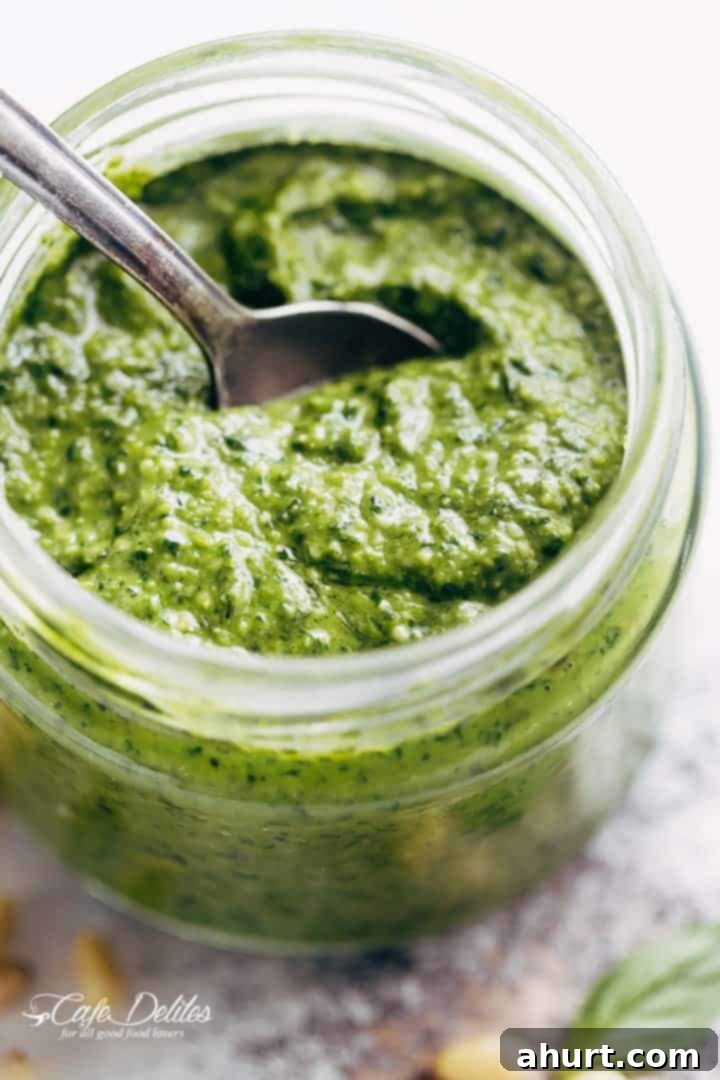Homemade Basil Pesto: The Ultimate Guide to Fresh, Flavorful, and Easy Pesto Sauce
Few things elevate a simple dish quite like fresh, vibrant homemade Basil Pesto. This iconic Italian sauce is more than just a condiment; it’s a burst of garden-fresh flavor that instantly transforms your cooking. Forget the bland, often dull store-bought versions – once you experience the rich aroma and exquisite taste of pesto made from scratch, you’ll understand why this recipe is a culinary staple you’ll want to keep on repeat.
Its versatility is truly what makes this basil pesto recipe so indispensable in any kitchen. Imagine it spooned generously over succulent grilled chicken, brushed onto tender roast meats, or simply tossed through a big bowl of al dente pasta or healthy zucchini noodles. Each application showcases its incredible ability to turn everyday meals into something extraordinary, vibrant, and bursting with fresh, herby goodness.
The beauty of crafting your own pesto lies in its simplicity. With just five core ingredients and the humble power of a trusty food processor, learning how to make pesto at home has never been easier. This quick and straightforward process means you can enjoy superior flavor and quality without any fuss. The moment you taste the difference – the bright basil, the creamy pine nuts, the sharp Parmesan, and the fruity olive oil – you’ll be convinced: homemade pesto is an absolute game-changer, and you’ll never settle for anything less.
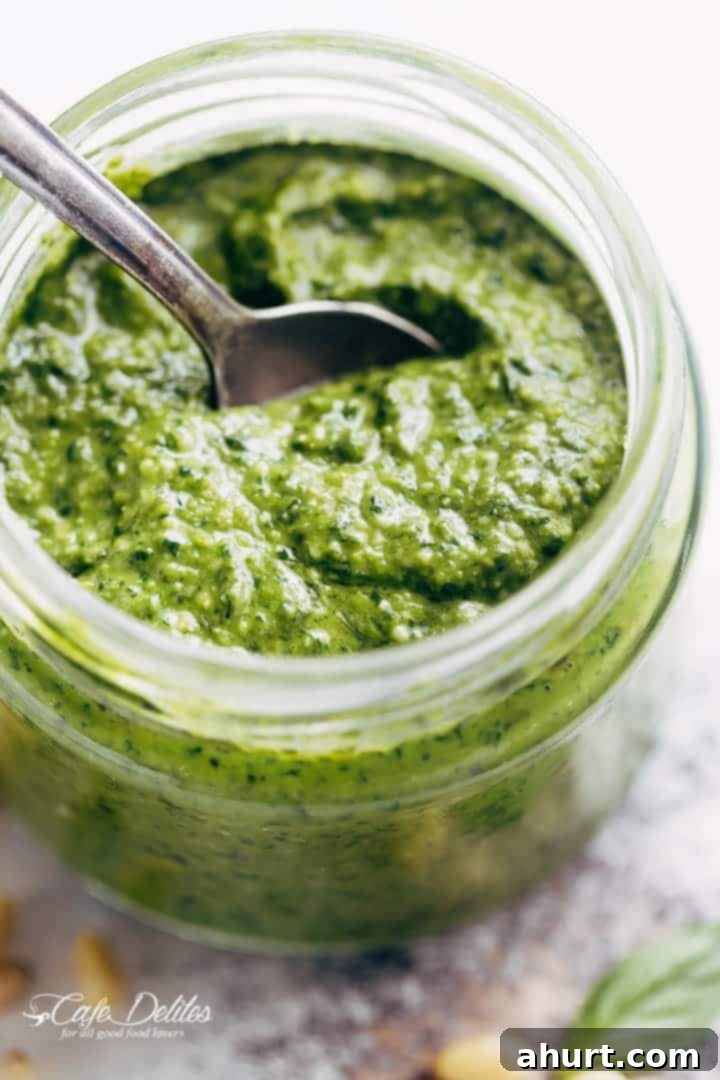
Why This Homemade Basil Pesto Recipe is a Must-Try
This basil pesto stands out because it strikes a perfect balance: fresh, bold, and incredibly harmonious. Each ingredient plays a crucial role in creating a symphony of flavors and textures. You get the unmistakable sweetness and aromatic intensity of fresh basil, the creamy richness of perfectly toasted pine nuts, the salty, umami depth of authentic Parmesan cheese, and the smooth, fruity finish of high-quality olive oil. A touch of garlic provides just the right amount of pungent kick without overpowering the other delicate notes.
What’s truly remarkable is that this gourmet-level sauce comes together in mere minutes. With just five simple ingredients, you can whip up a batch that tastes infinitely cleaner, brighter, and more vibrant than anything you could ever buy in a jar. This recipe is a testament to the power of fresh ingredients and simple techniques, proving unequivocally that learning how to make pesto at home is always worth the minimal effort for maximum flavor payoff.
Essential Ingredients for the Best Basil Pesto
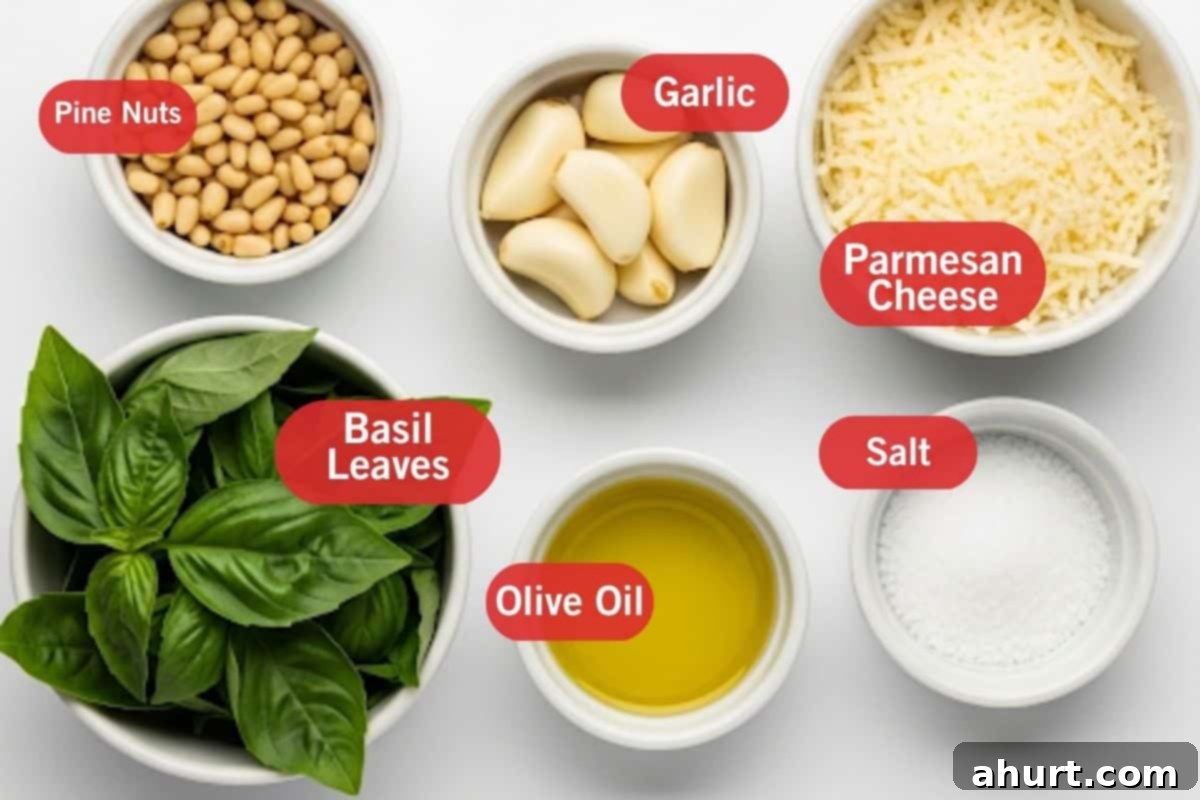
Achieving truly incredible basil pesto begins with selecting fresh, high-quality ingredients. With just a handful of essentials, this recipe comes together quickly and delivers an explosion of authentic Italian flavor.
- Basil Leaves: The undisputed star of the show. Use fresh, vibrant, fragrant basil leaves. Look for bright green leaves without any dark spots. They provide the signature herbal aroma, sweet undertones, and the vibrant green color that makes pesto so appealing. Gently wash and thoroughly dry them before use to prevent a watery pesto.
- Pine Nuts: These small, buttery nuts add a delightful creaminess and a subtle, earthy richness to the pesto. Lightly toasting them before blending is a crucial step that intensifies their flavor, giving the pesto an unparalleled depth.
- Parmesan Cheese: Always opt for freshly shredded or grated Parmesan cheese (Parmigiano-Reggiano, if possible). Pre-grated cheeses often contain anti-caking agents that can affect the texture and flavor. Freshly grated Parmesan offers a salty, nutty, and distinctly umami depth that is essential for authentic pesto. For a sharper, saltier kick, a blend of Parmesan and Pecorino Romano can also be used.
- Olive Oil: The quality of your olive oil greatly impacts the final taste. Choose a smooth, good-quality extra virgin olive oil. It not only helps blend the ingredients into a silky, luscious sauce but also contributes its own fruity, slightly peppery notes, enhancing the overall flavor profile.
- Garlic: Fresh garlic cloves are non-negotiable. They provide a pungent kick that complements the basil perfectly. The amount can be adjusted to your preference – a single small clove for a subtle hint, or two for a more pronounced garlic flavor.
- Salt: A pinch of salt is crucial for enhancing all the other flavors. Start with a small amount and adjust to taste at the end, as Parmesan cheese also contributes significant salinity.
Note: Please see the full recipe card at the bottom for exact measurements and a complete list of ingredients.
Step-by-Step Guide: Crafting Your Perfect Basil Pesto
Making basil pesto from scratch is surprisingly quick and straightforward, especially with a food processor. Follow these simple steps to achieve a perfectly balanced and flavorful sauce:
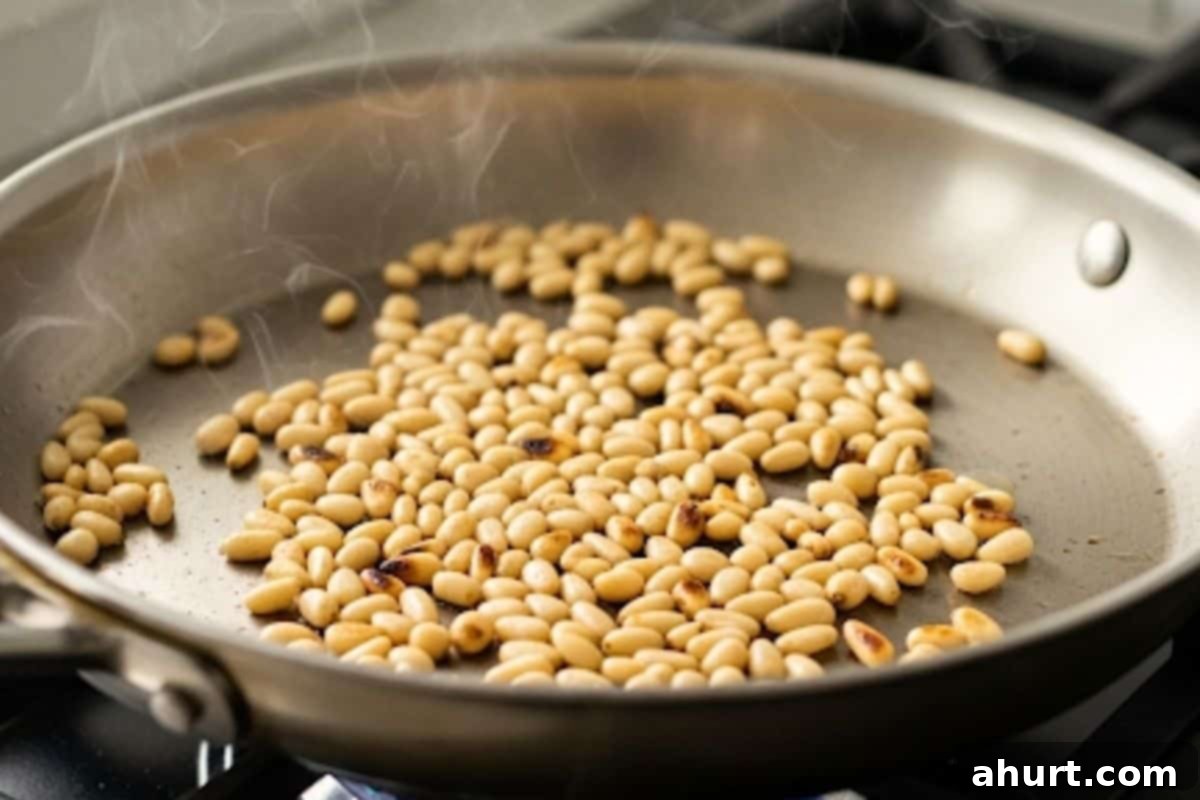
- Toast the Pine Nuts: Begin by heating a dry skillet over medium-high heat. Add the pine nuts and toast them gently, stirring or tossing frequently. This process usually takes 2-4 minutes. Watch them carefully, as they can burn quickly. Once they turn a light golden brown and become fragrant, immediately transfer them to a plate to cool slightly. Cooling prevents them from cooking further and ensures they maintain their rich flavor.
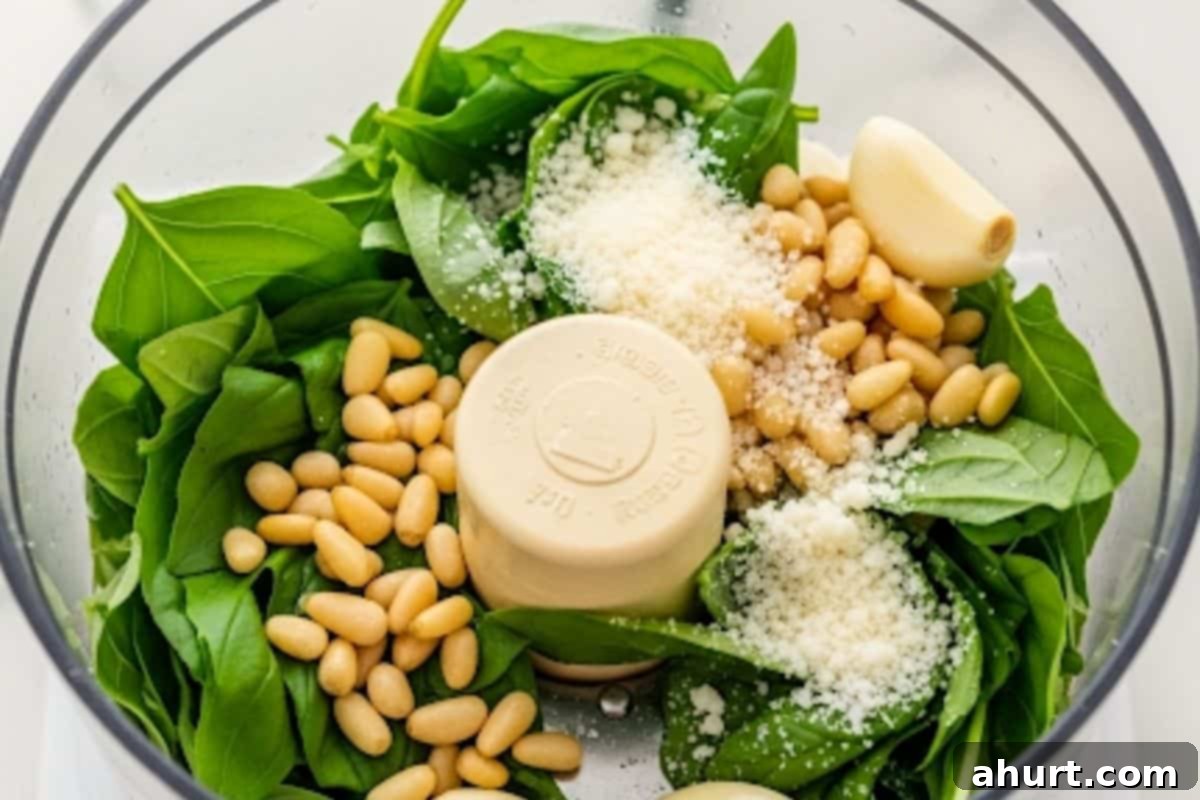
- Load and Pulse Ingredients: Once the pine nuts have cooled, add them to the bowl of your food processor. Follow with the fresh basil leaves, peeled garlic cloves, and freshly shredded Parmesan cheese. Pulse the mixture in short bursts until the ingredients are finely chopped and well combined, but still have some texture. Avoid over-processing at this stage, as you want a slightly coarse consistency, not a smooth paste. Be sure to scrape down the sides of the food processor bowl as needed to ensure everything is evenly chopped.
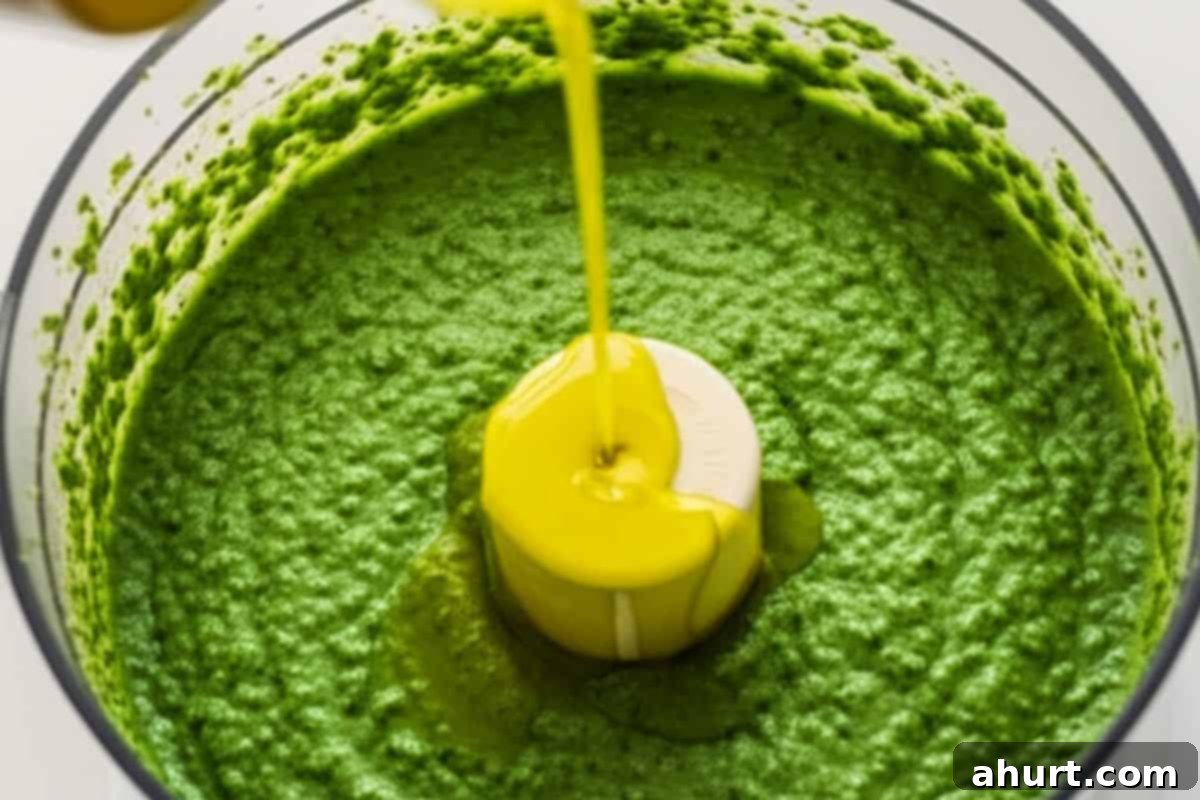
- Emulsify with Olive Oil: This is a crucial step for achieving the perfect pesto consistency. With the food processor running continuously, slowly stream in the olive oil through the feed tube in a thin, steady flow. Continue processing until the pesto looks smooth and well-emulsified. The oil will bind all the ingredients together, creating a rich, luscious sauce. Avoid pouring the oil in too quickly, as this can result in a greasy rather than creamy texture.
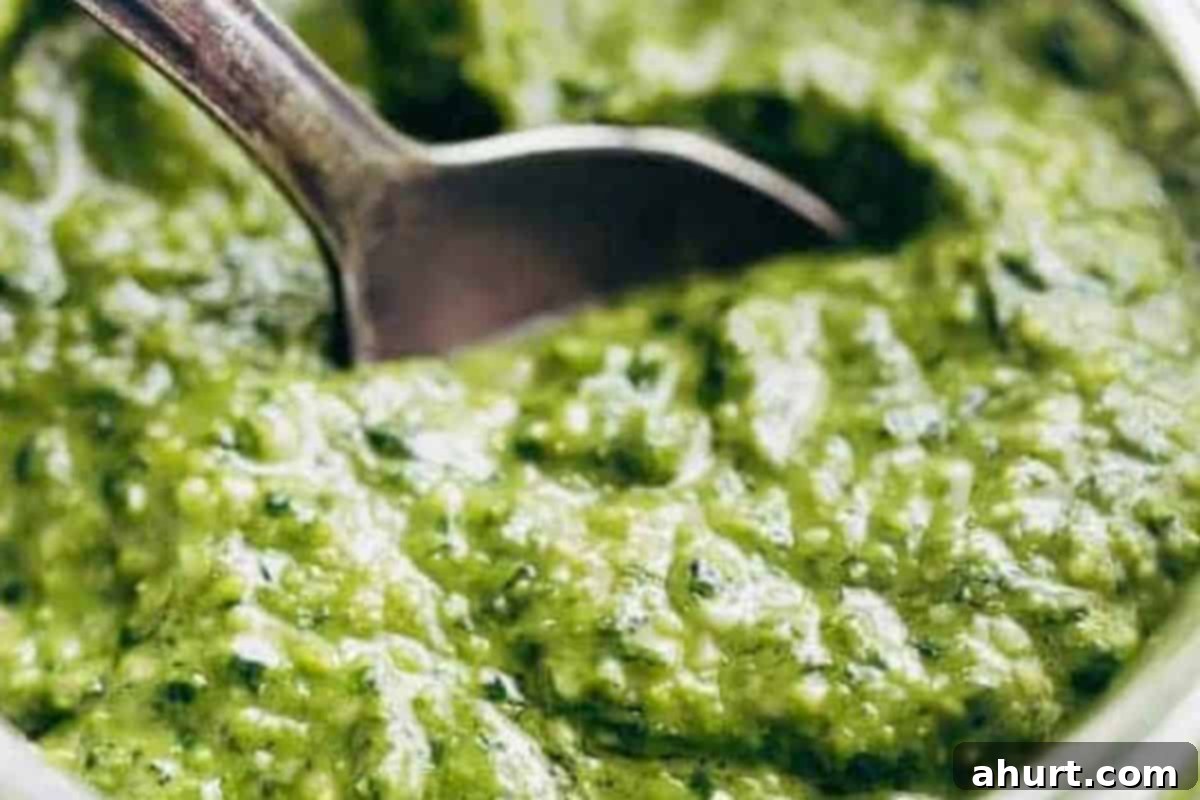
- Season and Adjust: Once the pesto is smooth, stop the processor. Add a pinch of salt and pulse a few more times to thoroughly combine. Now, taste the pesto. This is your chance to adjust the flavor to your preference. You might want a little more salt, or perhaps a touch more olive oil to achieve your desired consistency. Some prefer a squeeze of lemon juice at this stage to brighten the flavors and help prevent browning.
Basil pesto isn’t just for pasta; its robust and fresh flavor profile makes it an incredibly versatile addition to countless meals. Spread it over Crispy Slow Cooker Carnitas for a fresh, herby finish that cuts through the richness. Drizzle it onto Greek Lamb Souvlaki with a Garlic Yogurt Dip for a delightful Mediterranean twist. Or, serve it generously alongside Garlic Browned Butter Baked Asparagus for an easy, flavor-packed side dish that will impress. The possibilities are truly endless!
Tips for Perfect Homemade Basil Pesto
While making pesto is simple, a few expert tips can elevate your homemade version from good to absolutely incredible:
- Use the Freshest Ingredients: This cannot be stressed enough. Fresh, vibrant basil and good quality olive oil make a noticeable difference. Older basil can have a bitter taste, and low-quality olive oil can leave an unpleasant aftertaste.
- Toast Your Pine Nuts (Don’t Skip!): Toasting unlocks a deeper, richer, and creamier flavor from the pine nuts. It takes only a few minutes but adds immense complexity. Keep a close eye on them, as they burn quickly.
- Avoid Over-Processing: Pesto should have a slightly coarse, rustic texture, not a super smooth paste. Pulse in short bursts and scrape down the sides frequently. Over-processing can also generate too much heat, which can start to cook the basil and dull its vibrant color.
- Stream the Oil Slowly: Adding the olive oil in a slow, steady stream is key to achieving a beautifully emulsified and creamy pesto. Pouring it too quickly can result in a separated, oily sauce.
- Prevent Browning (Oxidation): Basil oxidizes rapidly, causing pesto to turn dark. To minimize this:
- Work quickly once basil is processed.
- Place a thin layer of olive oil directly on the surface of stored pesto.
- You can blanch the basil in boiling water for 15-30 seconds, then immediately shock it in an ice bath before drying thoroughly. This helps retain a brighter green color, though it can slightly reduce some delicate aromas.
- Adjust Consistency: If your pesto is too thick, add a little more olive oil or even a tablespoon of cold water until it reaches your desired consistency. If it’s too thin, you can add a few more pine nuts or Parmesan cheese and pulse again.
- Taste and Season: Always taste your pesto before serving. Adjust salt levels as needed, and consider a squeeze of fresh lemon juice to add a bright, acidic counterpoint that lifts all the flavors.
Beyond Pasta: Creative Ways to Enjoy Basil Pesto
Pesto is incredibly versatile and can be used in countless ways beyond the classic pasta dish. Its vibrant flavor makes it a fantastic addition to almost any savory meal:
- Pasta & Noodles: The most classic use! Toss with spaghetti, linguine, penne, gnocchi, or even zucchini noodles for a quick and flavorful meal.
- Sandwiches & Wraps: Spread pesto on bread or wraps instead of mayonnaise for a fresh, herby kick. It pairs wonderfully with chicken, turkey, mozzarella, and tomato.
- Eggs: Swirl a spoonful into scrambled eggs, omelets, or frittatas for an instant flavor boost.
- Grilled Meats & Fish: Brush pesto onto grilled chicken, steak, pork, salmon, or shrimp as a marinade or a finishing sauce.
- Roasted Vegetables: Drizzle over roasted asparagus, broccoli, potatoes, or bell peppers for added depth of flavor.
- Pizza & Flatbreads: Use it as a vibrant base for pizza instead of tomato sauce, or spread it on warm flatbread with some fresh mozzarella.
- Soups & Stews: Stir a dollop into vegetable soups, minestrone, or even a simple tomato soup right before serving for a burst of freshness.
- Dressings & Dips: Whisk pesto with a little extra olive oil and vinegar for a quick salad dressing, or mix it into Greek yogurt, sour cream, or cream cheese for a flavorful dip or spread.
- Bread: Serve with crusty bread for dipping, or mix it into softened butter for a delicious pesto butter.
- Potatoes: Toss with warm roasted potatoes or mix into mashed potatoes for an unexpected twist.
- Marinade: Use it as a quick and effective marinade for various proteins.
Basil Pesto Recipe FAQs
While you can skip this step if you’re truly short on time, toasting the pine nuts is highly recommended. It significantly enhances their nutty flavor and contributes a richer, more complex aroma and depth to the pesto. It only takes a few minutes in a dry skillet, so it’s a small effort for a big flavor payoff!
Basil leaves oxidize quickly when exposed to air, which causes them to turn brown. To minimize this, ensure you’re using very fresh basil, work quickly when blending, and store your pesto properly. For storage, cover the surface of the pesto directly with a thin layer of olive oil or plastic wrap before sealing it in an airtight container. Some chefs also blanch basil quickly in boiling water before shocking it in an ice bath to help retain its vibrant green color, though this is an optional step.
Absolutely! For a delicious nut-free basil pesto recipe, you can substitute pine nuts with sunflower seeds or pumpkin seeds. To ensure maximum flavor, lightly toast these seeds as you would the pine nuts. Hemp seeds also work well and offer a slightly grassy, earthy flavor. Always ensure any chosen substitute is suitable for your dietary needs.
When stored correctly, fresh homemade basil pesto can last for about 1-2 weeks in an airtight container in the refrigerator. Make sure to cover the surface of the pesto with a thin layer of olive oil before sealing the container to prevent oxidation and keep it fresh and vibrant green. For longer storage, pesto freezes beautifully for up to 3-6 months.
While classic pesto is traditionally made with basil, you can certainly experiment with other herbs or greens! Popular variations include using parsley, cilantro, arugula, spinach, or even mint for a different flavor profile. You can also combine basil with other herbs to create unique blends. The general technique remains the same, but the flavor will, of course, change significantly.
Freezing pesto is an excellent way to preserve its freshness. The best method is to portion it into ice cube trays. Once frozen solid (usually a few hours), pop the pesto cubes out and transfer them to a freezer-safe bag or container. This allows you to thaw just the amount you need, whenever you need it. Alternatively, you can freeze it in small airtight containers, ensuring a layer of olive oil is on top before sealing.
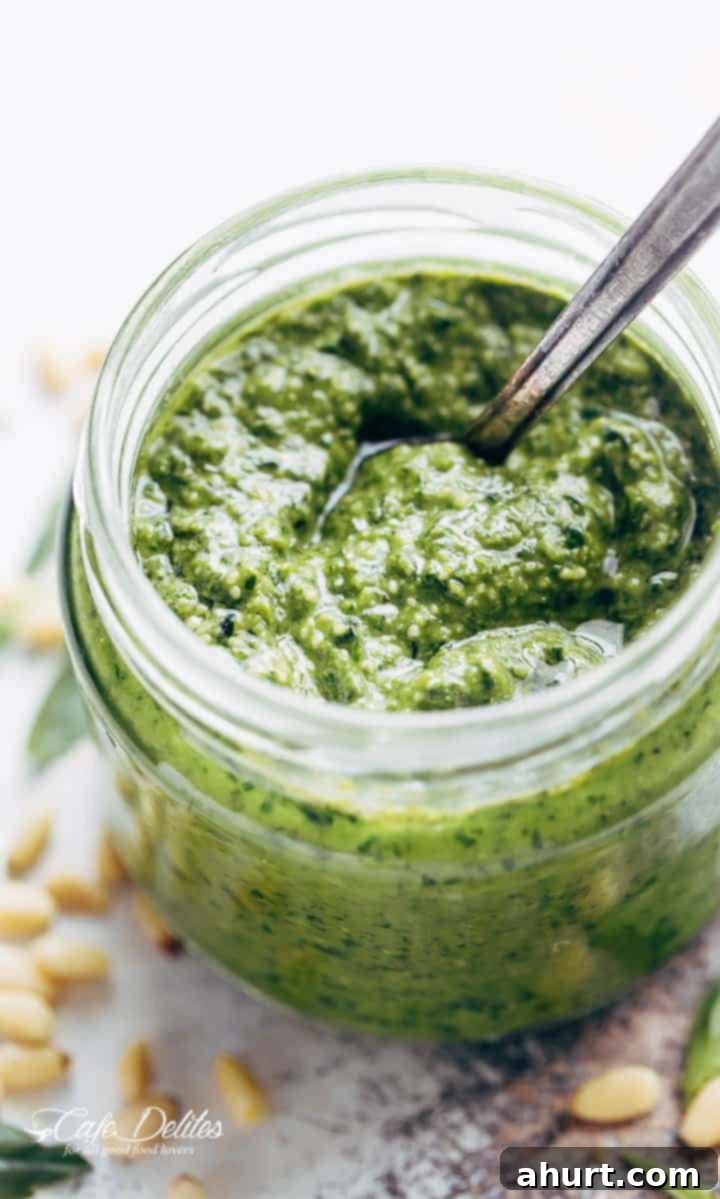
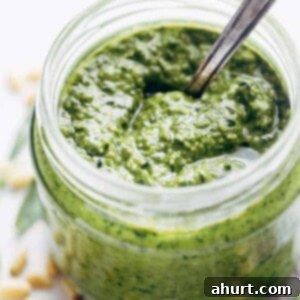
Pin
Basil Pesto
Ingredients
- 1/4 cup pine nuts lightly toasted
- 2 cups basil leaves washed and packed
- 2 cloves garlic peeled
- 1/3 cup parmesan cheese fresh shredded
- 1/3 cup olive oil
- 1 pinch salt
Instructions
-
Heat a dry skillet (or pan) over medium-high heat. Add the pine nuts and toast until they turn a light golden brown, tossing occasionally to prevent burning. Immediately transfer them to a plate to cool. Once cooled, add the pine nuts, basil leaves, garlic, and Parmesan cheese to the bowl of your food processor. Pulse the mixture until all ingredients are finely chopped, scraping down the sides of the food processor as needed to ensure even processing.
-
With the food processor running continuously, gradually add the olive oil in a slow, thin stream through the feed tube. Continue to process until the pesto comes together and appears smooth and well combined. Scrape down the sides of the food processor bowl once more if necessary. Finally, add a pinch of salt to your taste and pulse again to fully incorporate. Taste and adjust seasoning as desired.
Notes
Nutritional Label: Based on 2 tablespoons of pesto per serve.
Nutrition
Nutrition information is automatically calculated, so should only be used as an approximation.
